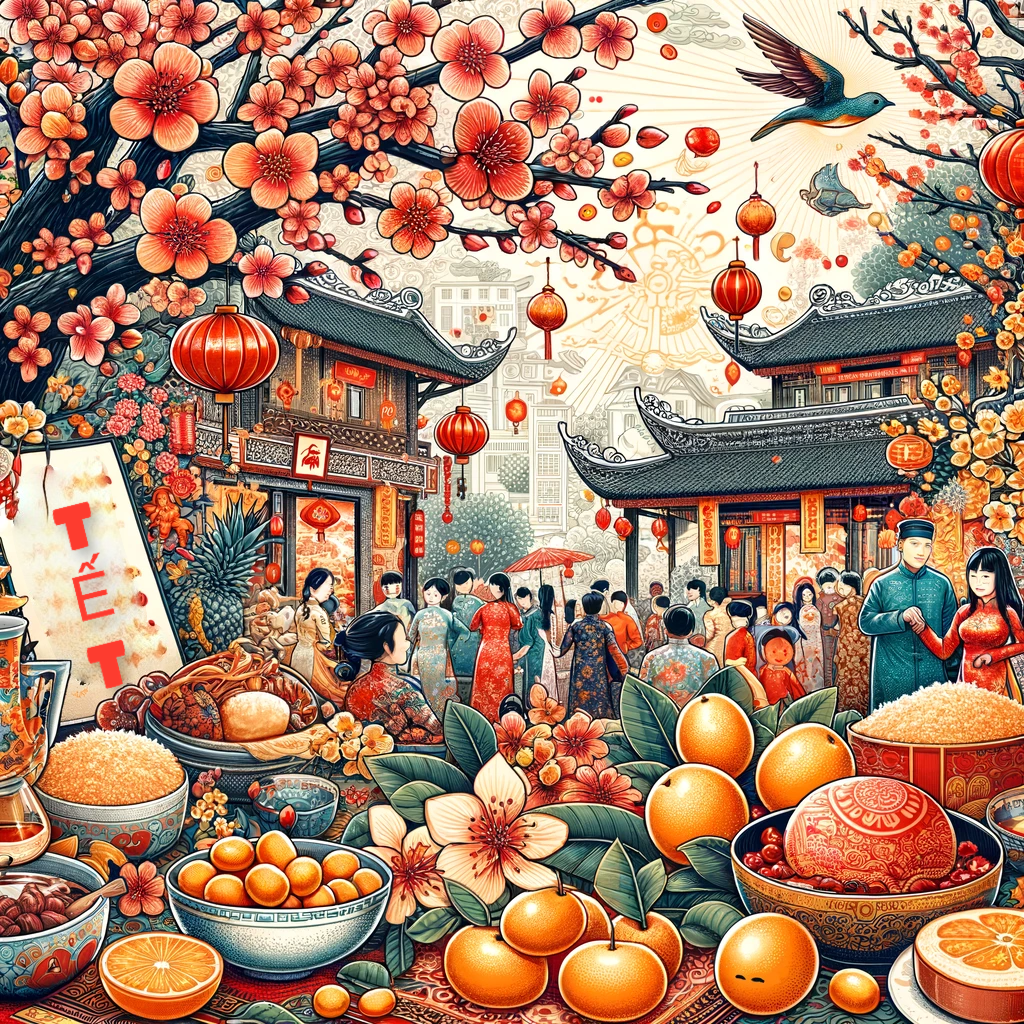The Lunar New Year, or Tết Nguyên Đán, holds a particularly special place in the heart of Vietnamese culture, reflecting traditions and customs that have been shaped by Vietnam’s rich history, which spans 4000 to 7000 years. This deep historical context underscores the unique evolution of Tết in Vietnam, distinguishing it from similar celebrations in other countries. Vietnam’s history, characterized by its resilience, diversity, and rich cultural heritage, has seen the development of its own distinct identity, which is vividly expressed through Tết.
From as early as the Phung Nguyen culture (around 2000-1400 BCE), which marks one of the beginnings of Vietnam’s civilization, the Vietnamese people have cultivated a deep connection with agriculture, community, and the cycles of nature. This connection is beautifully manifested in the Lunar New Year celebrations, where the end of the harvest season and the beginning of a new year are celebrated with joy, hope, and reverence for ancestors. The ancient Vietnamese, living in a society deeply rooted in agricultural and familial values, used the lunar calendar to organize their lives around the seasons and farming cycles, laying the groundwork for what would become Tết.
As Vietnam’s history unfolded over millennia, through periods of independence, dynastic rule, and external influences, the celebration of Tết evolved to incorporate various cultural elements and rituals. However, the essence of Tết as a time for family reunions, honoring ancestors, and welcoming the new year with optimism and festivities remained constant. The traditions such as the preparation of Bánh Chưng and Bánh Tét, the careful selection of the first visitor to ensure good luck, and the vibrant displays of flowers and decorations, are all reflective of Vietnam’s agricultural roots and the socio-cultural dynamics that have shaped its history.
Tết is thus not merely an adoption of the Lunar New Year from neighboring cultures but a celebration deeply ingrained in Vietnam’s own historical development. It is a testament to the enduring spirit of the Vietnamese people, their respect for tradition, and their celebration of life’s cyclical nature. The history of Vietnam, from its early agricultural societies to its modern incarnation, is mirrored in the celebration of Tết, making it a uniquely Vietnamese festival that honors the country’s ancient past and its continuous journey through time.
PS: It’s essential to recognize that the origination of the Lunar New Year extends beyond any single culture or country’s traditions. This celebration, deeply rooted in ancient human civilization, reflects the universal practice of using lunar cycles to measure time, an approach that predates written history and spans across continents. While the Lunar New Year is widely recognized and often associated with the Chinese New Year due to the extensive scale and rich customs of the celebration in China, its origins are not confined to China alone.
The basis of the Lunar New Year can be traced back to various ancient cultures around the world, each of which observed the moon’s phases and developed their own lunar calendars and festivals:
- Mesopotamia: Considered one of the cradles of civilization, ancient Mesopotamians used a lunar calendar system as early as the 3rd millennium BCE.
- Ancient Egypt: Initially utilized a lunar calendar before transitioning to a solar calendar, the ancient Egyptians also recognized the significance of the lunar cycle in their religious and cultural practices.
- China: Developed a sophisticated lunar calendar that has influenced many Asian cultures. The Chinese Lunar New Year, with its zodiac system and rituals, is a prominent celebration but is a part of a broader tradition that encompasses various cultures.
- India: The Hindu calendar is a lunisolar calendar with deep historical roots, reflecting the importance of both lunar and solar cycles in traditional festivals and rituals.
- Islamic World: The Islamic, or Hijri, calendar is a purely lunar calendar, used to determine the dates of Islamic holidays, including Ramadan, based on the sighting of the moon.
Each country and culture that observes the Lunar New Year has adapted the celebration to fit their unique historical, cultural, and social contexts. For instance, Vietnam’s Tết, Korea’s Seollal, and Mongolia’s Tsagaan Sar are all variations of the Lunar New Year celebration, each with distinct customs, foods, and rituals that reflect their national identity and cultural heritage.
This diversity in celebration underscores the Lunar New Year’s rich tapestry of human culture, a testament to the shared yet distinct ways communities across the world have observed the passage of time and the cycles of life. The universal nature of lunar observation highlights our common humanity, reminding us of the ancient roots that connect us across cultures and continents.

